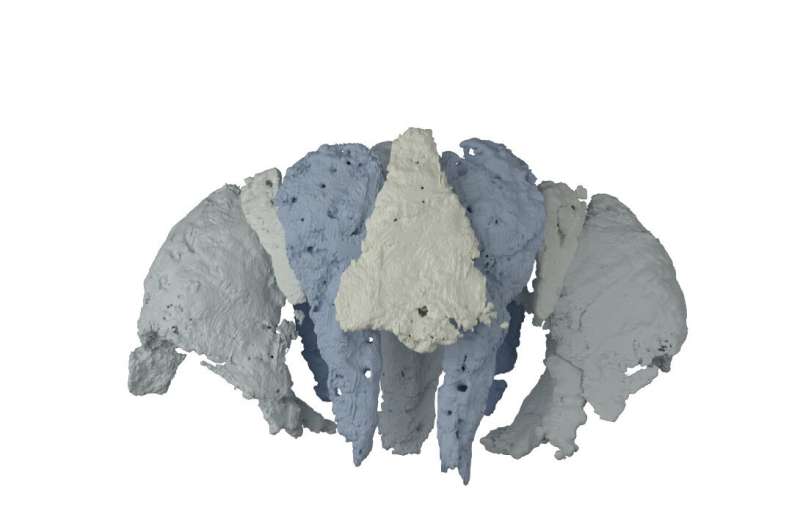Image of work flow, showing fossil and 3D image. Credit: Field Museum of Natural History, Richard Dearden and Ivan Samson.
A 455-million-year-old fossil fish provides a new perspective on how vertebrates evolved to protect their brains, a study has found.
In a paper published in Nature today (Sept. 20), researchers from the University of Birmingham, Naturalis Biodiversity Center in Leiden, Netherlands, and the Natural History Museum have pieced together the skull of Eriptychius americanus.
The research suggests that the ancient jawless fish found in ancient deposits in Colorado, U.S., has a skull unlike that of any previously seen, and fills a gap currently spanning 100 million years in the evolutionary history of the vertebrate skull.
Using computed tomography, a form of X-ray technique, scientists recreated a detailed 3D representation of the skull of Eriptychius and is the first time that such a comprehensive recreation has been done on the specimen which was collected in the 1940s, originally described in the 1960s and is housed in the Field Museum of Natural History, Chicago.
This ancient fish had separated, independent cartilages encasing the brain, rather than the solid bone or cartilage structure of jawless and jawed fish that followed it.
Video showing the 3D model created by the researchers. Credit: Field Museum of Natural History, Richard Dearden and Ivan Samson.
While later species have a fully bound cage of cartilage that holds the brain, these results suggest that the early evolution of structures to separate the brain from other parts of the head may have begun with Eriptychius.
Dr. Ivan Sansom, Senior Lecturer in Paleobiology at the University of Birmingham and senior author of the paper said, "These are tremendously exciting results that may reveal the early evolutionary history of how primitive vertebrates protected their brains. Eriptychius americanus appears to be the first evidence for a series of cartilages separating the brain from the rest of the head. This study emphasizes the importance of museum collections and the application of new techniques in studying them."
-
Image of the Eriptychius fossil. Credit: Field Museum of Natural History and Ivan Samson.
-
Eriptychius reconstruction. Credit: Field Museum of Natural History, Richard Dearden
Dr. Richard Dearden, Postdoctoral Research Fellow in Paleobiology at Naturalis Biodiversity Center and lead author of the paper said, "On the face of it Eriptychius is not the most beautiful of fossils. However, by using modern imaging techniques we were able to show that it preserves something unique: the oldest three-dimensionally preserved vertebrate head in the fossil record. This fills a major gap in our understanding of the evolution of the skull of all vertebrates, ultimately including humans."
More information: Richard Dearden, The oldest three-dimensionally preserved vertebrate neurocranium, Nature (2023). DOI: 10.1038/s41586-023-06538-y. www.nature.com/articles/s41586-023-06538-y
Journal information: Nature
Provided by University of Birmingham


























